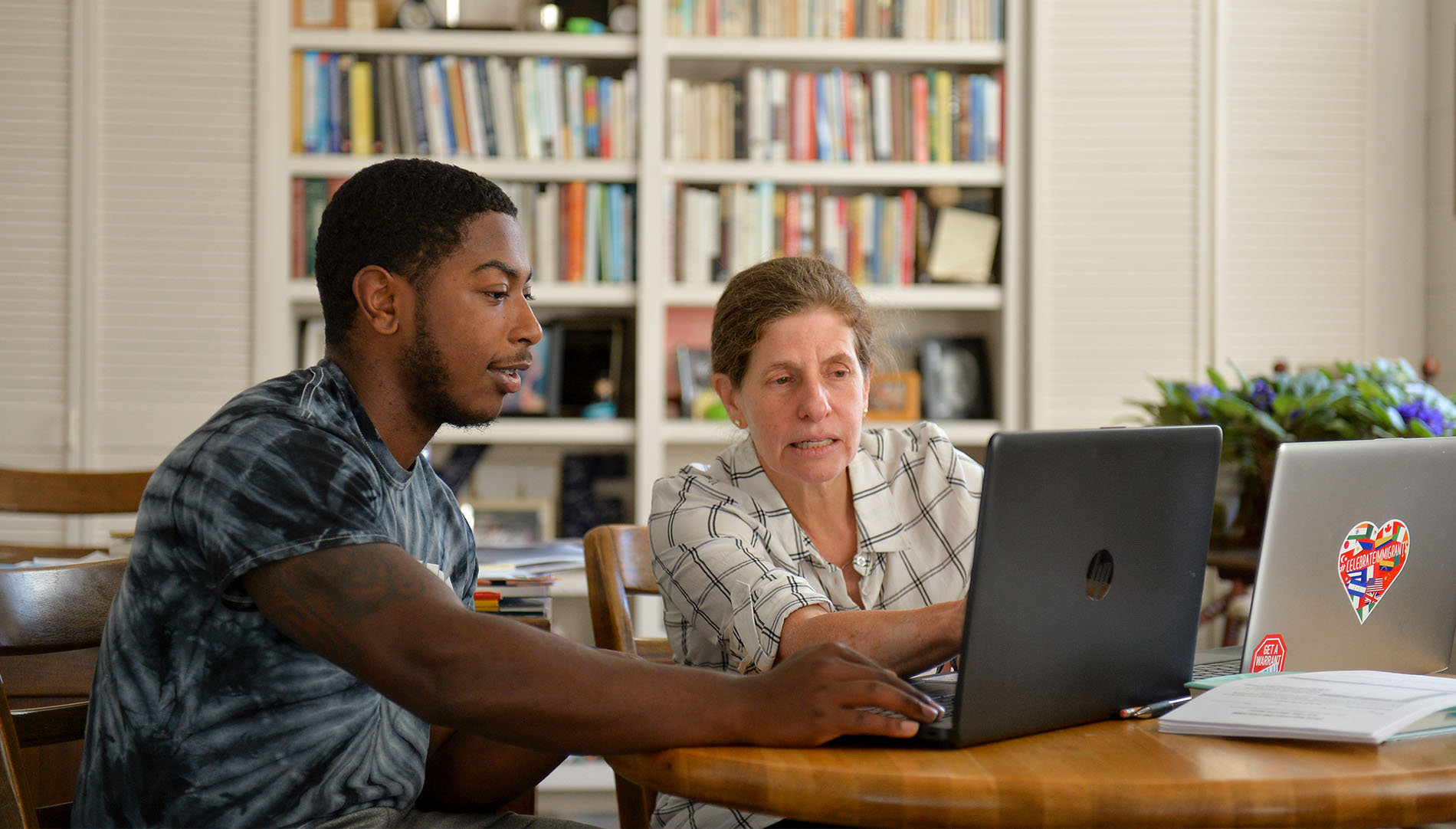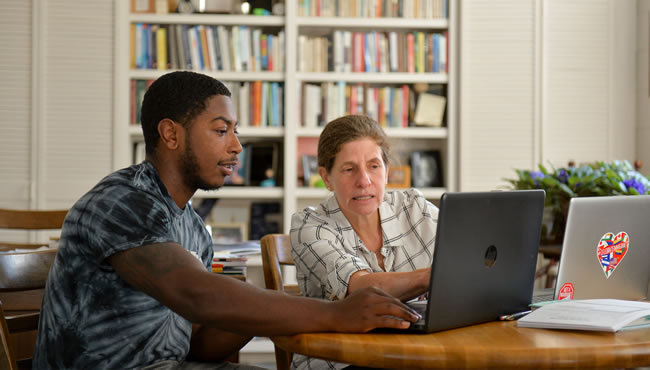Many people upload a headshot and resume, type out a professional-sounding byline and think they are finished curating their online presence. However, to stand out in the myriad of online professionals today, managing an online profile or portfolio takes more than a catchy title and engaging photo. This resource will help professionals navigate the choices they need to consider when crafting an online space – where to share content, what content to share and how to update after being hired.
WHERE TO SHARE
In each industry, there are different expectations for professionals online. The first step to managing your online presence is to learn these expectations and identify the audience (different employers). Next, find out, based on your field, what you need to share with the public about your professional life. For some industries, a digital resume or LinkedIn space may be the only requirement. For others, creating an online portfolio could give more context or share a more robust picture of your experience. For example, having a website allows professionals to add reflection or share hyperlinks to work samples or experiences. A website also allows professionals to share visual elements that more clearly communicate a skill set.
Beyond LinkedIn, there are also industry-specific website profiles. For example, researchgate.net allows scholars to share their professional publications and research while dribbble.com is a space where creatives can share work samples. When curating a professional presence online, find digital spaces your industry uses. Then decide on your focus. Are you actively promoting yourself for a job or maintaining a catalog of your work? Depending on your priority, you may spend time working on one type of profile over another.
WHAT TO SHARE
Once you pick the type of profile you need, the next step is to decide what to share in your online spaces. Sometimes it is advantageous for professionals to build a portfolio website rather than simply linking to content on a profile. For example, a graphic designer may share hyperlinks to places where employers can see their design online. A portfolio website can also showcase different iterations of a single project or work samples with more description about the design process. Similarly, someone in the sciences might link to publications on researchgate.net, but a portfolio space could build in room to describe a person’s specific roles or relationships to larger research or projects. Brainstorm the different projects and experiences that you want to showcase to make the most of your space.
Still, an online presence is not just about being seen. It is also about forming digital relationships and connections within your industry. Having a variety of profiles and websites can allow you to connect and stay up to date on industry-specific trends. Someone may discover your content and reach out. However, you will be more noticeable and memorable if you are sharing updates or commenting on conversations around industry-specific discussions. As you begin to follow and connect with other professionals in your field, your profile will also act as a collection of historical connections, helping you reconnect with and remember people you have met at in-person events or in other industry spaces.
As you consider what you want to share with others – whether it is work samples or conversations – ask yourself how your social media fits into these spaces. In some industries, social media platforms need to be public and professional because the industry uses those spaces for connections. If this is the case in your industry, make sure that your personal brand is cohesive across the internet. Delete photos that are unnecessary, harmful and not applicable to your image from your social media accounts. The themes of your professional story should be congruent across all platforms.
HOW TO SHARE
1. SAVE AND REFLECT ON WORK
If you are a college student, start by systematically saving your best work. Was there a lab that taught you something important? Did you have an internship experience that gave you new expertise? Brainstorm some examples, and then create a cloud-based place to save images, final projects and document why these projects were meaningful. By gathering your experiences in this space, you are practicing reflective work that will help you build a portfolio and answer future interview questions. You will be able to look back at these notes and projects and remember the most impactful moments from your college career.
Many college students headed into the job market have significant work from their courses that is related to their future employment, but they do not know how to connect classroom work to their industry. Or sometimes students have digital files that are more akin to a box of keepsakes in an attic than to a thoughtful website arrangement. Just as a museum curator must sort through works of art or artifacts and decide on the arrangement of an exhibit, students must decide what work is worth showcasing and why. Does certain work show off a skill set that makes you stand out? Do other projects show off a specialty area for you? Rather than sharing everything you have ever worked on, consider how specific work, experiences or projects tell your unique professional story.
2. TELL YOUR STORY
For students in certain fields, sharing a professional story can feel complicated or disjointed. For a college student training to become a teacher, it is easy to highlight lesson plans, education-related research projects and a teaching philosophy in a professional portfolio. But if you are a math major or a history major, you may feel you lack clear language to communicate your assets. When you are equipped to work for a variety of industries, tailoring a website can feel more intimidating when a role requires less specific credentialing. For this reason, draft a thesis or mission statement to focus your website. Next, set up a clear website structure with named categories. Arrange these pages, sections and projects to clearly support this thesis. As you name your experiences, you will be able to organize your story more easily. Then as you curate your website for a particular industry or audience, the structure and organization will allow your audience to easily understand your purpose and goals.
For professionals who could work in different industries, there are ways to create and hide multiple pages or iterations of a website or profile. Just as professionals tailor resumes for certain jobs, you can make categories and pages public or private depending on the jobs you’re applying for.
3. OTHER PORTFOLIO ELEMENTS
Once you have your main idea and structure, fill in your site with a short career biography. Along with the work you highlight on your pages, include skill sets, degrees, certifications, professional development, awards, etc. When writing your “about me” section, think beyond your list of accomplishments and give your reader context. How did you end up where you are? What inspires you? Why do you think your work is important? Let your reader in beyond resume-speak. Still, keep in mind that there is such a thing as too much personal information. Especially refrain from including your address or phone number in this section or in any other uploaded document such as a resume.
Another element that can make an impressive addition to your digital space is testimonials or recommendations from important people you have worked with in your field. Have them write a brief quote about your strengths or what you add to a team. Some profiles have a specific space for this addition. If not, you can build one or create a space where people can request recommendations.
Looking to make your portfolio stand out even more? Here is a list of questions to ask yourself to see if there is additional content to consider including:
- Has a unique personal experience influenced your professional goals? Include this in your storytelling and portfolio in some way.
- Did a hobby or interest spark your professional life? If connected to your professional experience, share about your hobbies.
- Has location played a factor in your professional decision-making? Share a digital map that aligns with your professional experiences.
Let these questions help you brainstorm unique aspects of your professional journey, but keep a balance between displaying personality, coming across as memorable and maintaining a professional tone.
4. GET FEEDBACK
Seeking professional feedback is valuable. First, identify professionals who might be able to give you industry-specific advice. Ask college or graduate school professors, a college career center, internship coordinators or other connections in your field to review your digital presence. Share your professional goals and intent for the digital spaces with your reviewer. Here is a list of feedback suggestions to ask your reviewers to consider:
- Overall impression: Ask whether the space communicates your personal brand and expresses content unity. Ask the reviewer to determine whether the space is easy to use, understand and navigate. Is it pleasing as well as functional?
- Content relevance: Ask whether what you have included fits industry standards and expectations while helping you stand out.
- Content clarity: Ask whether your content clearly expresses your intent. Ask your reviewer to look for errors or confusing elements of the text.
5. UPDATE YOUR ONLINE PRESENCE:
Finally, once you have a job, it can be tempting to let your digital presence grow stale or outdated. However, creating a system or schedule for updating your portfolio monthly, biannually or annually can be valuable for your professional goals and online presence.
Start by taking a step back and looking at the design and branding. Does it look old or outdated? Does it include internet trends that have been left behind? Consider whether the look and feel of your software choice needs updating. Are there new platforms you should consider joining or more effectively leveraging?
Next, add recent accomplishments or projects. Spend time reflecting on how they still connect to your overall thesis and structure. Then remove outdated or irrelevant content. Ask yourself, “Are my goals still the same? Does my thesis still work? Is the ‘about me’ section still on target?” If not, begin by refreshing your goals and theme. Do not forget to update your digital or social support. Check that all hyperlinks are functioning or add new digital content or mentions to your site.
Review your testimonials and recommendations. Consider asking someone new to contribute to this section or remove outdated recommendations. Then seek feedback from professionals you trust as before.
As you look over your digital presence or get started with this guide, remember your online portfolio should define who you are as a professional, give evidence for this definition, and then help you connect with others in your field. If you are just starting college, rather than beginning with your online presence, check out this roadmap to building a resume year by year. A resume can act as a jumping-off point for your future digital portfolio.



